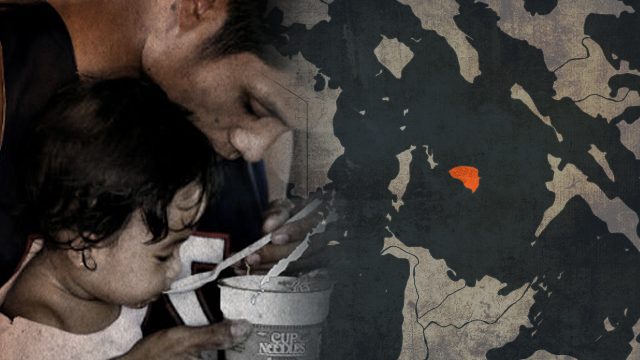SUMMARY
This is AI generated summarization, which may have errors. For context, always refer to the full article.

ILOILO, Philippines – Many small Philippine islands are prone to disasters and hazards, both natural and man-made, among them, Sibuyan island in Romblon province which constantly faces the threat of typhoons that annually pass through the Visayas area.
Sibuyan Island is the second largest in Romblon with a total land area of approximately 45,600 hectares. It is surrounded by the islands of Marinduque in the north, Panay in the south, Masbate in the east, and Romblon and Tablas in the west.
The island is also comprised of 3 major municipalities: Cajidiocan, Magdiwang, and San Fernando.
Biodiversity hotspot
Sibuyan island is considered a hot spot for biodiversity conservation because of its high level of endemism.
It holds the record for the densest forest in the world with 1,551 trees per hectare. About 140 square kilometers or 33% of the island’s land area is basically primary forest. Due to the steep slopes, a large part of the island’s original forest remains untouched.
Although most of the forested area consist of lowland forest, the island has a full range of forest gradient in the Philippines consisting of mangrove, lowland, montane, mossy forests, heathland, and grassland.
Never in the island’s geological history has it ever been connected with any part of the Philippine archipelago, according to Sibuyan Island Sentinels League for Environment, Incorporated (ISLE), a multi-sectoral non-profit organization.
Due to its biodiversity, the island has been called the Galapagos Island of Asia by international and local scientists. It is one of the richest spots in the world in terms of diversity, density, and endemism of fauna and flora.
To reach the island, it takes a 5-hour trip by sea from Capiz, and 20 hours if one is coming from Batangas. The periods of isolation due to rough seas are becoming more unpredictable according to Andres C. Tionko, Executive Director of the Panay Rural Development Center, Incorporated.
Poverty profile
In 2013, the population was 132 persons per square kilometers or 58,598 persons for the entire island.
Based on the projected population of the 2010 Census, Romblon has a growth rate of 0.78%. In 2010, there were 57,248 inhabitants of the island. Migration is possibly one of the main reasons for the low population growth rate.
Ninety percent of the population live in the coastal and low-lying areas. Data show that 66.7% of the total number of households in the island live below the poverty threshold, while 53.52% live below the food threshold.
Further data showed that the island’s statistics is higher compared to that of the entire province of Romblon, with only 62.10% of households living below the poverty threshold, and 49.22% households living below the food threshold.
The sources of income in the island are farming, fishing in municipal waters, public service (local government employees and officials and public school teachers), remittances from relatives outside the island, eco-tourism, and mining.
Government spending, which includes the internal revenue allotment (IRA), public service, infrastructure projects and development programs like the Pantawid Pamilyang Pilipino Program (4Ps), will largely fuel the island’s economy in the foreseeable future.
Rice deficiency
A rising problem in Sibuyan Island is rice deficiency which affects at least two of the island’s municipalities – Cajidiocan and San Fernando. (READ: How food insecurity threatens us)
Based on 2013 data, the required number of 50-kilogram sacks is 139,465 combined in all 3 municipalities, but the production capacity is only 112,212, meaning the deficiency is 27,253 sacks. The breakdown per municipality for the required number of sacks is: Cajidiocan (51,642), Magdiwang (33,092), and San Fernando (54,731).
However, the production capacity is: Cajidiocan (41,901), Magdiwang (39,428), and San Fernando (30,883). According to the data, Cajidiocan has a deficit of 9,741 sacks while San Fernando has a deficit of 23,848. Magdiwang has a surplus of 6,336.
It is projected that by 2016, the rice deficit in Sibuyan island will reach 30,542 sacks, equivalent to 1,527 metric tons. By 2020, it will be 35,050 sacks or 1,752.5 metric tons.
Recommendations
According to Tionko, there are several possible options for rice sufficiency:
- Develop new rice farms while protecting current ones from land use conversion
- Increase production per hectare from 3 metric tons to 3.9 metric tons in 2016 and 4 metric tons in 2020
- Increase cropping intensity from 2 to 2.5 per year or 5 croppings in 2 years
- Reduce per capita consumption of rice from 119 kg per year to 97 kg per year in 2016 and to 94 kg/year in 2020
- Improve harvest and post-harvest efficiency
- Supply stabilization and buffer stocking of imported rice (from neighboring islands)
- Reduce population
Indigenous people (IP) communities in the island are engaged in taro chip production and are active in reviving traditional food sources like root crops.
At the moment, Tionko believes that it is “more practical and pragmatic to redirect the attention of concerned agencies on the buffer stocking of food or supplies and enhancing food security in the island.” – Rappler.com
Anthony Mondragon holds a degree in Journalism from West Visayas State University and is taking up a Masters’ Degree in Mass Communications from the same university. He currently works as the Knowledge Management Coordinator for the Antique Federation of Non-Government Organizations (AFON), Inc.
Add a comment
How does this make you feel?
There are no comments yet. Add your comment to start the conversation.